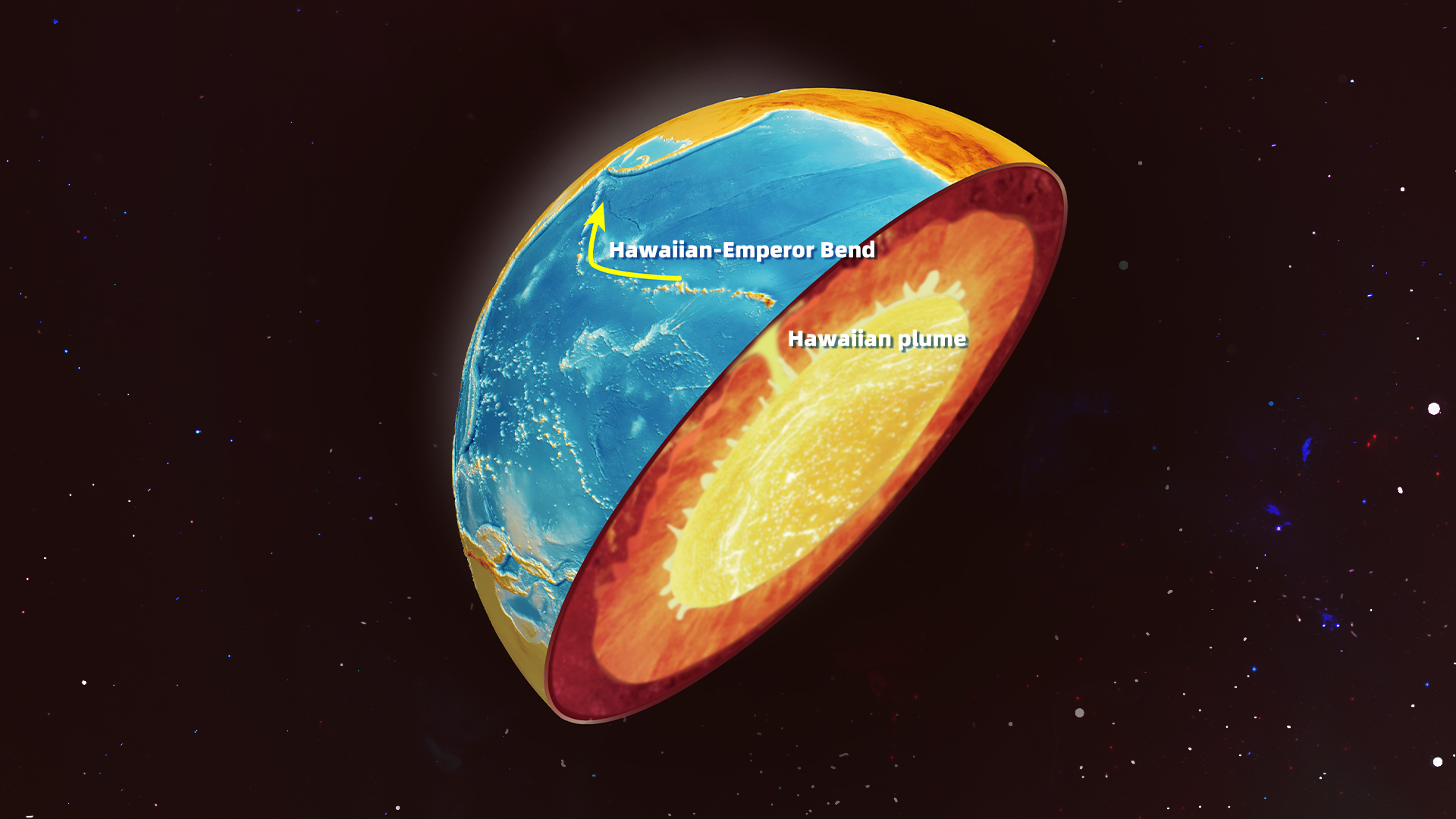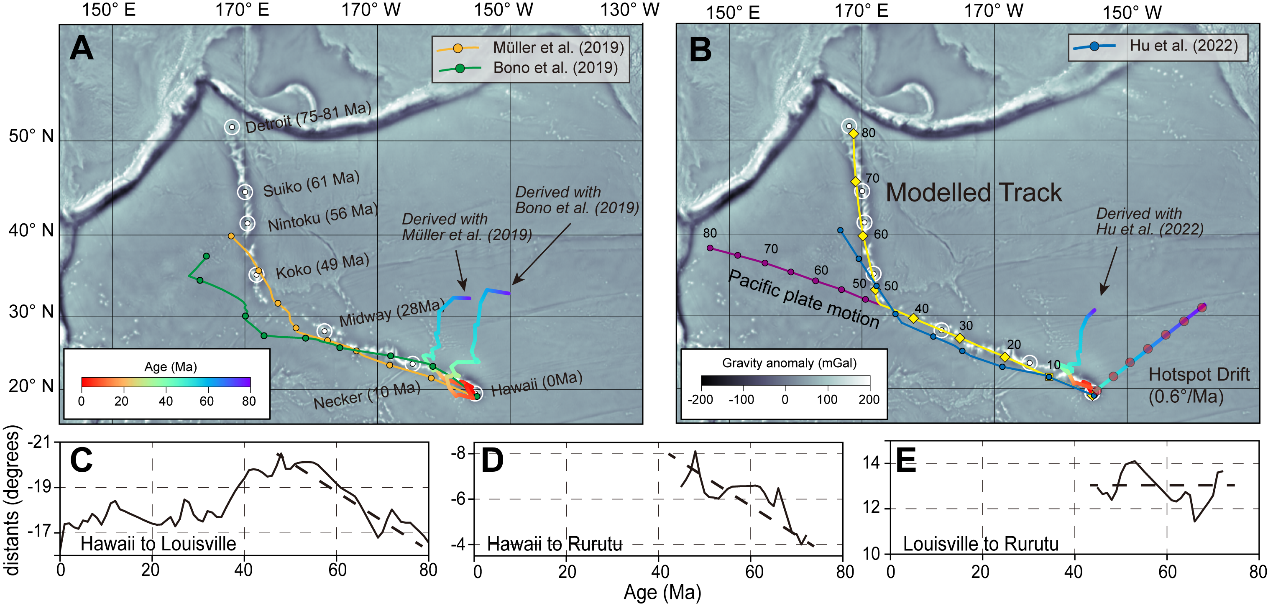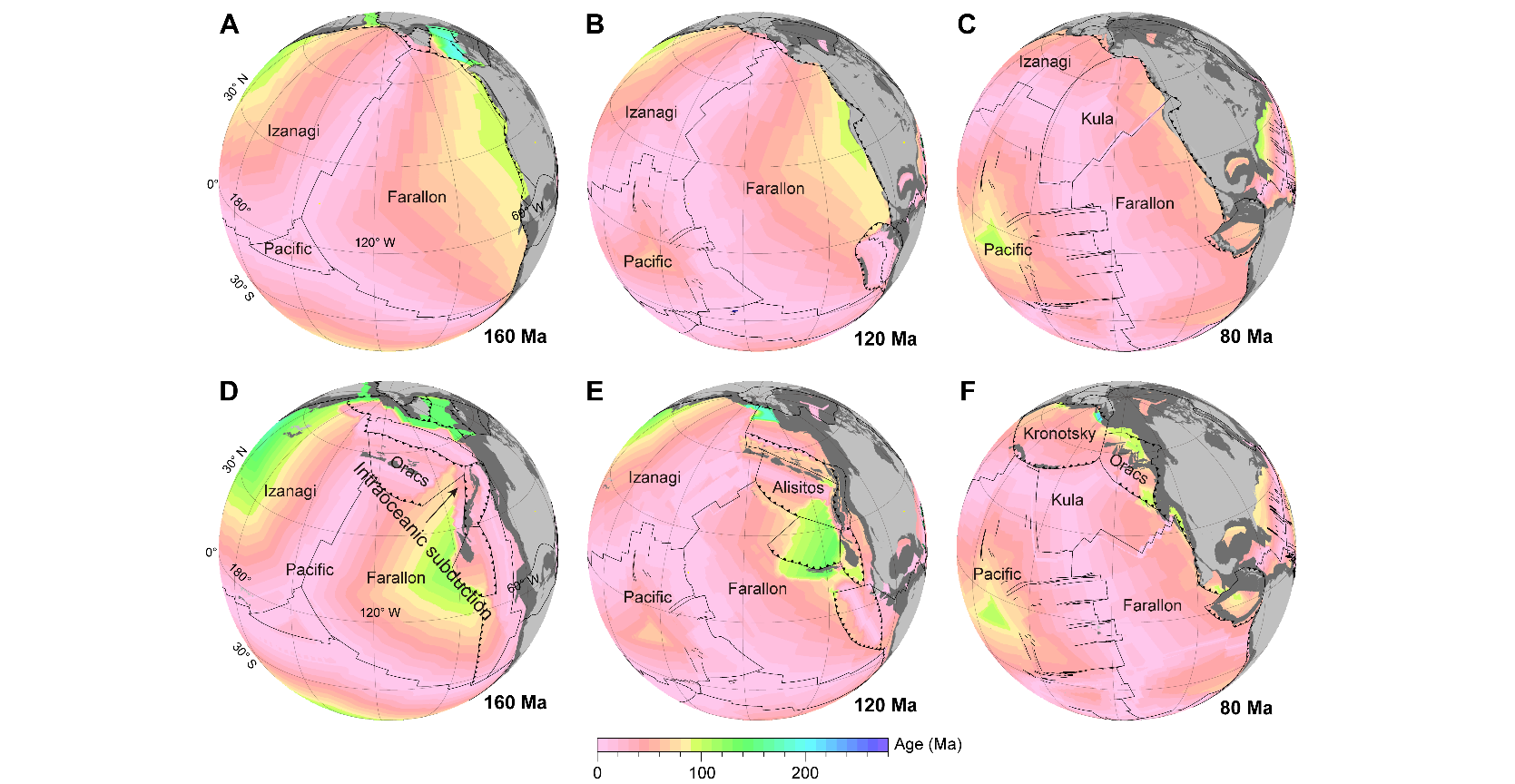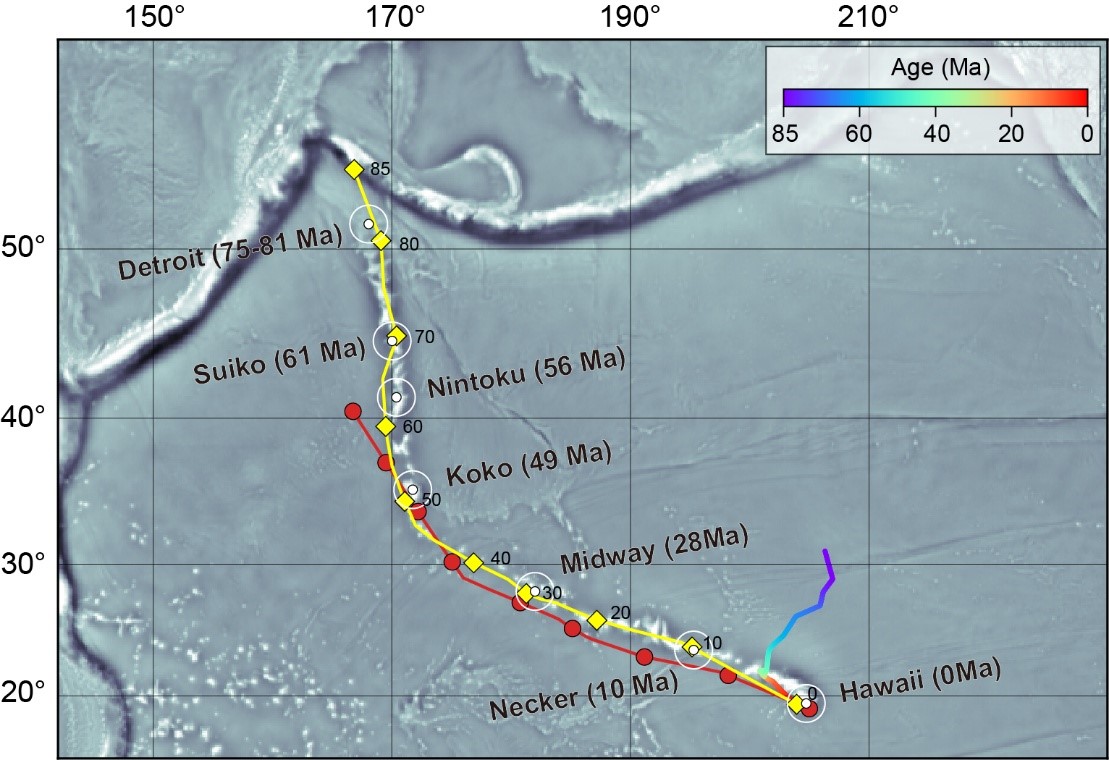The Hawaiian-Emperor Seamount Chain is one of the most prominent geological features of the North Pacific and has been central to the development of the mantle plume hypothesis. In 1963, J. Tuzo Wilson proposed that intraplate volcanism in the Pacific was caused by a stationary hotspot eroding the overlying Pacific plate, producing a linear chain of volcanoes —the Hawaiian-Emperor Seamount Chain—as the plate moved. In the 1970s, W. Jason Morgan advanced this idea by suggesting that hotspots originated from narrow plumes of hot material upwelling from the deep mantle, giving rise to the mantle plume hypothesis. While this theory explains the existence of the seamount chain, one striking feature—the nearly 60° bend that formed around 47 million years ago (Ma)—has remained an unsolved problem in geodynamics.
Two main hypotheses have been debated for decades. One attributes the bend to a sudden rotation in Pacific plate motion, assuming fixed mantle plumes. The other, supported by paleomagnetic evidence, indicates that the paleolatitude of the Emperor Seamounts differs by more than 10° from that of present-day Hawaiian volcanoes, suggesting that the Hawaiian hotspot drifted southward during the past 80+ million years. This finding challenged the fixed-hotspot paradigm and pointed to hotspot drift as a key driver of the bend. However, neither hypothesis alone can fully reproduce the observed seamount chain geometry. Pacific plate rotation models lack a fully elucidated dynamical mechanism, while hotspot drift alone cannot account for the full bend. As a result, the Hawaiian-Emperor Bend has remained a “legacy problem” at the intersection of plate tectonics and mantle plume theory.

A research team led by Associate Professor Jiashun Hu from the Department of Earth and Space Sciences at the Southern University of Science and Technology (SUSTech) has provided the first comprehensive explanation. Using a global mantle convection model, they reconstructed the Hawaiian hotspot’s complete motion trajectory over the past 80 million years. By integrating numerical simulations with the latest plate reconstruction results, they quantified the relative contributions of Pacific Plate rotation and hotspot drift to the formation of the Hawaiian-Emperor Bend, proposing a comprehensive and self-consistent geodynamic mechanism.
Their paper, titled “Dynamics of longitudinal Hawaiian hotspot motion and the formation of the Hawaiian-Emperor Bend,” has been published in Proceedings of the National Academy of Sciences (PNAS).
The researchers have long been dedicated to understanding the origin of the Hawaiian-Emperor Bend. Their previous work (Hu et al., 2022, Nature Geoscience) used high-resolution global mantle flow models to reproduce a ~30° rotation of the Pacific plate at ~47 Ma, consistent with the latest plate reconstructions. This implies that the remaining ~30° of the bend must be explained by hotspot motion.
Further geometric analysis of the seamount chain revealed that, in addition to the well-documented southward drift, the Hawaiian hotspot also experienced significant westward drift—comparable in magnitude to the contemporaneous westward motion of the Pacific plate (Figure 1). Yet the physical mechanism behind this westward drift has remained unclear, and it had never been reproduced in mantle convection models.

Figure 1. Motion of the Hawaiian hotspot inferred from geometric simulation and distance analysis of hotspot tracks. (A) Inferred Hawaiian hotspot trajectory using the absolute kinematic models of Müller et al. (2019), which used the updated West–East Antarctic circuit, and Bono et al. (2019) that used the Australia–Lord Howe Rise circuit. (B) Inferred Hawaiian hotspot trajectories assuming the Pacific Plate motion predicted by the geodynamic model of Hu et al. (2022), which assumes the Pacific plate moves with a constant angular velocity to the north–west. (C-E) The longitudinal distances between same-age volcanoes of different hotspot tracks (Hawaiian, Louisville, and Rurutu) in the Pacific. The minus sign indicates that the former is to the west of the latter; values indicate relative longitude.
To address this challenge, the team proposed that intra-oceanic subduction systems in the northeastern Pacific were the key driving force behind the westward motion of the Hawaiian hotspot. Compared with traditional “Andean-type” subduction reconstructions, their reconstruction shifts the trench system westward by nearly 2000 km. This adjustment significantly alters the lower-mantle flow field in the Pacific domain once the subducted slabs penetrate the lower mantle, thereby affecting the hotspot’s drift trajectory (Figure 2). This reconstruction was then assimilated into a data-constrained global mantle convection model.

Figure 2. (A-C) The traditional plate reconstruction assumes Andean-type subduction beneath North America. (D-F) The plate reconstruction that considers the intraoceanic subduction system in the northeastern Pacific.
The simulation successfully reproduced the present-day location of the Hawaiian hotspot and its westward drift during 80–47 Ma (Figure 3). When combined with the previously modeled Pacific plate rotation (Hu et al., 2022), the model was able to reproduce the nearly 60° Hawaiian-Emperor Bend with remarkable accuracy.
Quantitative analysis showed that Pacific plate rotation contributed approximately 30–35° to the bend, while hotspot motion accounted for the remaining 25–30°. Among the hotspot contributions, westward drift accounted for roughly 20°—exceeding that of southward drift—with the latter playing a crucial role in matching the Emperor Seamount paleolatitudes. Comparative simulations using traditional Andean-type reconstructions failed to reproduce the westward drift, underscoring the importance of the northeastern Pacific intra-oceanic subduction system.

Figure 3. The multicolored trajectory represents the motion of the Hawaiian plume in the reference model. The red line indicates the Pacific Plate motion track proposed by Hu et al. (2022), and the yellow line represents the predicted hotspot track.
This study reveals the long-sought dynamic cause of the Hawaiian hotspot’s westward motion and, for the first time, reproduces the present-day position of the hotspot within a global mantle convection framework. It offers a coherent geodynamic explanation for the Hawaiian-Emperor Bend, providing fresh insights into this long-standing scientific puzzle. More broadly, it establishes a theoretical framework for understanding plate-mantle interactions and plume dynamics, with significant implications for the study of Earth’s deep interior.
Ph.D. candidate Jie Zhang is the first author of this paper, and Associate Professor Jiashun Hu is the corresponding author. SUSTech is the first affiliated institution.
Paper link: https://doi.org/10.1073/pnas.2510972122
To read all stories about SUSTech science, subscribe to the monthly SUSTech Newsletter.
Proofread ByAdrian Cremin, Yifei REN
Photo ByDepartment of Earth and Space Sciences